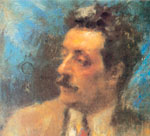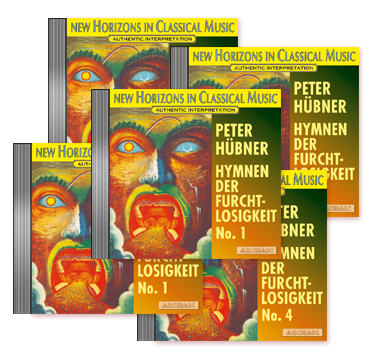
Richard Strauss
Richard Strauss
on his work
at his two Operas
Elektra &
Der Rosenkavalier
“While the ideas were flowing in upon me – the motives, themes, structure
melodies, harmonic garb, instrumentation – in fact the entire musical
measure by measure – it seemed to me that I was dictated to by two
wholly different Omnipotent Entities. I imagine that Shakespeare experienced
similar sensations when he wrote such widely contrasting works as King Richard
III and Midsummer Night’s Dream. The capacity for the reception of
so totally diverse influxes fills me with amazement.”
|
|
THE COMPOSER ON HIS
HYMNS OF
FEARLESSNESS |
|
 Giacomo Puccini
Giacomo Puccini
Giacomo Puccini
ON HIS IDEAL CONDUCTOR
“Did you ever hear Toscanini conduct La Boheme? Well, you have something
of great moment to look forward to.
No other conductor gets out of my scores what he does. It was Toscanini who conducted
the premiere of La Boheme at Turino.
He was then only twentynine years old. His interpretation was more than a
great reproduction – it was a veritable recreation.
I sat there enthralled.
Toscanini and I often disagree; we have violent quarrels and call each other
all kinds of vile names, but we always become reconciled again, because
we have a genuine respect for each other as musicians. I am nine years older
than he is, but in many ways, he is musically much more advanced than I am.
He is a genius! Under his magic baton, my scores, and those of Wagner and Verdi,
become illumined and the manner in which he translates that luminosity into
sound baffles description.
Moreover, Toscanini
conducts everything from memory. His phenomenal memory is the despair of all
other conductors.
When I heard him lead the orchestra and singers through the four acts of La
Boheme at that Turino premiere without a note in front of him, I felt like
shouting what Nicodemus said to Jesus: ‘Rabbi, we know that thou art
a teacher come from God; for no man can do these miracles thou doest except
God be with him.’”
|
| |
CLASSIC-Life: Herr Hübner, can you tell us something about your “Hymns of Fearlessness”?
PETER HÜBNER: The “Hymns of Fearlessness” form the synthesis of various generations
of “Hymns of the Dancing Dragon” – two worlds poles apart,
for which – as far as the archaic orchestras in the different hymns
are concerned – it is partly easy and partly difficult to join together.
The “Hymn of Fearlessness No. 1” consists of one chorus and an archaic
orchestra. Chorus and orchestra lie tonally several generations apart.
The “Hymn of Fearlessness No. 2” consists of one chorus and two orchestras
– the two orchestras tonally playing neighbouring generations, such as
grandparents / parents or parents / children or children / grandchildren.
The “Hymn of Fearlessness No. 3” has three orchestras, which are
tonally related to each other in a first and second degree of relationship,
i.e. for instance grandparents / parents / children.
The “Hymn of Fearlessness No. 4” has 4 orchestras which are tonally
related to each other in a first, second and third degree, i.e. great-grandparents,
grandparents, parents and children – all four generations under the one
roof of this hymn.
The “Hymn of Fearlessness No. 5” has 5 orchestras which are tonally
related to each other in a first, second, third and fourth degree, i.e. great-grandparents,
grandparents, parents, children and grandchildren.
With every additional generation under the roof of the hymn, the tension and
chaos: the less calculable rhythmical and tonal order increases – as
far as the whole orchestra is concerned.
The person who has sung the chorus to these hymns in all five related houses,
has learned what fearlessness means: not to be confused by the chaotic environmental
effects of the orchestra, including release, explosions and spectres in the
various generations.
The picture on the CD-cover shows the prehistoric giant Ymir, known from Germanic
mythology, who embodies the cosmic ability to think, and can supposedly give
a person who unexpectedly sees him inside, a tremendous fright – even
heroes, who are otherwise regarded as fearless, are said to have shaken like
a leaf at the unexpected sight of the prehistoric giant Ymir. People claim
that only the self personally and/or the soul could perhaps look at the prehistoric
giant Ymir, without being afraid – and that is in fact when it concerns
the “Great Soul”. The great philosophers say that the universal
faces the cosmic without fear.
Ymir is the most comprehensive perception of thinking and its effects on neurophysiology as well as the entire cosmos.
Ymir is therefore also the ancient symbol for the cosmic ability to think
and perceive. |
|



